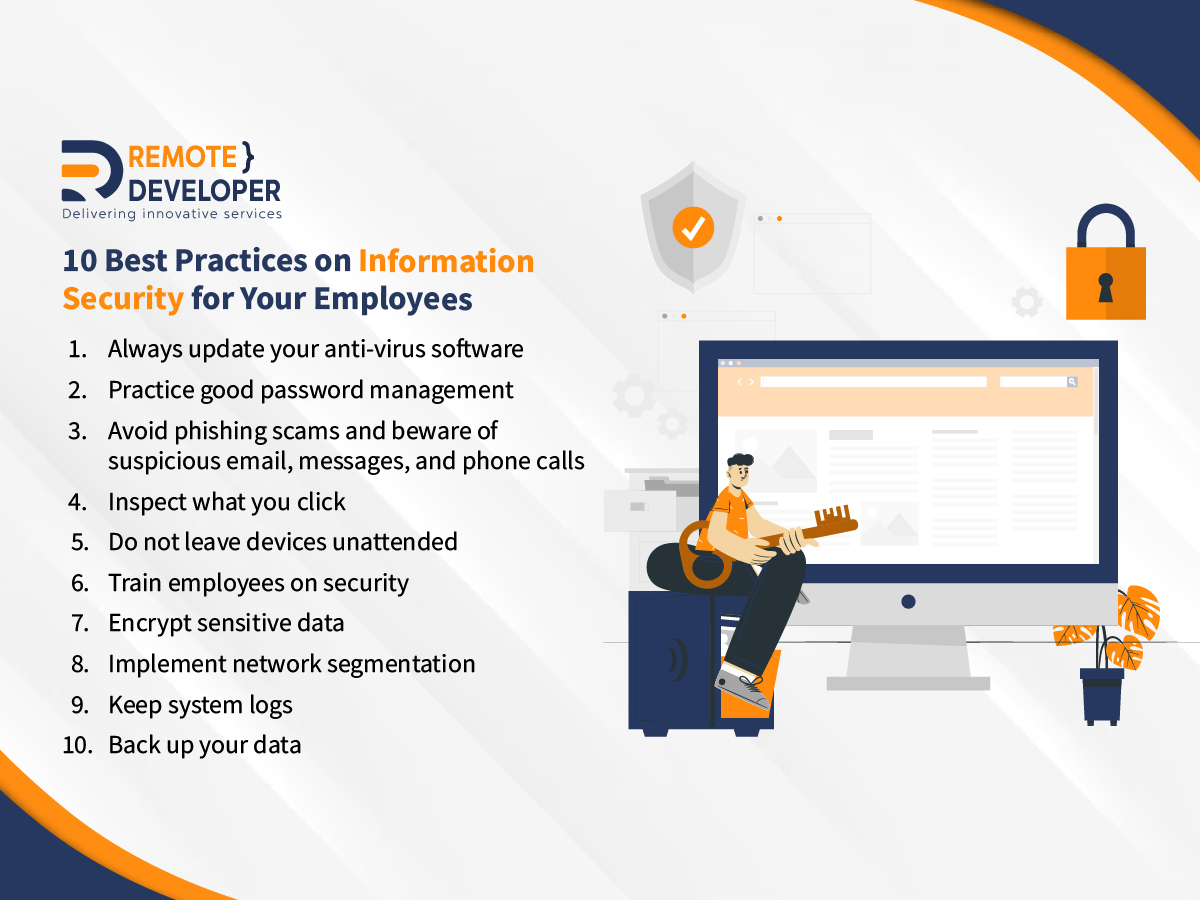Information security has proven essential to every organisation’s operation in today’s digital age. With the increasing commonness of cyber threats, businesses must prioritise protecting sensitive information. While deploying robust security systems and technologies is essential, an organisation’s employees and management play a pivotal role in ensuring comprehensive information security.
This article provides an insightful guide on the ten best practices employees and management should follow to safeguard valuable data and maintain a secure work environment. From basic cybersecurity hygiene to advanced strategies, these information security practices encompass various measures employees and management should adopt. Through these tips, organisations can enhance their resilience against evolving threats and instil a culture of information security throughout the workforce.
So, whether you are an employee handling sensitive data or a manager overseeing security protocols, this article will equip you with the information and tools necessary to protect your organisation’s critical information assets. Let’s explore the ten best practices that will empower your employees and management to become proactive guardians of data security.
What Is Information Security?
Information security is a critical component of any organisation’s overall security strategy. It protects information from unauthorised access, use, disclosure, disruption, modification, or destruction.
Information security covers many topics, including physical security, network security, application security, and data protection. It also includes measures such as encryption and authentication to protect the confidentiality and integrity of data.
As such, it is a complex and ever-evolving field that requires relentless vigilance to ensure that sensitive data remains secure.
Why is Information Security Important?
In today’s digital world, information security is of paramount importance. With the rise of cybercrime, companies, and individuals must take measures to protect their data from malicious actors. Information security is crucial because it ensures that confidential data remains secure and that only authorised users can access it.
It also helps protect employees against identity theft, fraud, and other malicious activities. Furthermore, information security safeguards businesses from financial losses due to data breaches or other incidents.
How can you implement information security in your business?
As mentioned earlier, implementing information security within your business is crucial to protect valuable data, maintain customer trust, and mitigate the risks of cyber threats. Here are some critical steps to effectively implement information security measures:

1. Continually update your anti-virus software
Installing and regularly updating anti-virus software is necessary for any organisation or individual who wants to protect their data and information from malicious programs.
Anti-virus software installed on your employees’ devices protects your data and information from malicious programs. It helps to detect, prevent, and remove viruses, malware, spyware, and other malicious programs from your computer.
Likewise, it also helps to keep your system up to date with the newest security patches and updates. Regularly updating the anti-virus software on your devices can ensure that it remains secure against the latest threats.
2. Practice good password management
Password management is another good information security practice you should implement in your organisation. Good password management is essential for keeping your online accounts secure and safe.
With the increasing number of cyber-attacks, ensuring that your passwords are strong and unique is more important than ever. But with so many accounts and passwords to remember, it can be challenging to manage them all. That’s why password management practices are so important.
Furthermore, you can also use it to generate strong passwords, which will be challenging to guess or crack. You can also use two-factor authentication whenever possible is an excellent means to add an extra layer of security to your accounts.
3. Avoid phishing scams and beware of suspicious emails, messages, and phone calls.
Phishing scams can have a devastating effect on security, both for individuals and organisations. Through malicious links and attachments, it can steal sensitive information such as passwords, financial information, or even personal data. It can also be used to spread malware and ransomware, which can damage your system, network, and devices.
Phishing scams are becoming increasingly sophisticated and challenging to detect. They often target specific individuals or organisations by impersonating legitimate companies or websites to gain access to their data. This makes it especially important for individuals and organisations to protect themselves against these threats.
Thus, another security best practice for companies is to have complete employee guidelines. Here are some steps to help you prevent phishing scams:
- Train your employees about the dangers of phishing scams. Teach them how to identify and scrutinise email addresses, suspicious links, attachments, and sensitive information over email.
- Utilise anti-phishing tools and software that can help detect and block suspicious emails or websites. These tools can analyse links and attachments, flagging potential phishing attempts.
- Configure email filters to block or flag suspicious emails. Enable spam detection mechanisms to reduce the chances of phishing emails reaching employees’ inboxes.
- Secure website connections: Ensure that your company’s website uses secure connections (HTTPS) to protect user data. This helps prevent phishing attacks that attempt to steal sensitive information.
- Develop an incident response plan summarising steps to take in case of a successful phishing attack.
4. Inspect what you click
Knowing the risks associated with online activities is vital as the world becomes increasingly digital. With the rise of cybercrime, taking proper precautions when browsing the internet is essential. One of the best information security practices to protect yourself and your data is to inspect what you click.
By being mindful of what websites and links you visit and ensuring they are secure, you can severely reduce your risk of falling victim to a malicious attack. One way to inspect links is by hovering your mouse cursor over it to reveal the actual URL. Verify that the link’s destination matches the one displayed in the text or email. Be wary of shortened links or URLs that appear suspicious or unfamiliar.
5. Do not leave devices unattended
Leaving devices unattended can be a security risk, leaving them vulnerable to theft, malicious actors, and other forms of attack. This is particularly correct in the case of laptops and mobile phones, which can contain confidential data such as passwords, credit card numbers, and other personal information.
As such, organisations must have policies that ensure employees do not leave their devices unattended. Companies can also implement an automatic lock setting on office devices. To do this, companies should configure devices to automatically lock after a period of inactivity.
Then, they should enable screen lock functionality on all work devices, including laptops, desktop computers, tablets, and smartphones. This ensures that the device requires authentication, such as a password, PIN, pattern, or biometric verification, to unlock and access its contents.
By doing so, they can reduce the risk of a data breach or other malicious activity from taking place on their systems.
6. Train employees on security
Information security is a crucial part of any business, and training employees on the subject is essential to ensure that all employees know the importance of protecting confidential data.
With cyberattacks becoming increasingly sophisticated, companies must equip their staff with the necessary skills and knowledge to protect their systems from malicious actors. Training employees on information security can help them understand how to identify potential threats, implement preventive measures, and respond quickly in case of a breach.
Businesses can protect their data from malicious actors by equipping staff with these skills.
7. Encrypt sensitive data
Encrypting sensitive data is a critical information security practice in protecting your personal and business information. It helps to ensure that only authorised individuals have access to it, preventing unauthorised access from hackers and other malicious actors. Likewise, it also stops data from being stolen or manipulated, ensuring that it remains confidential and secure.
Here are some steps to help you encrypt sensitive data effectively:
- Determine which data needs to be encrypted. This can include financial records, confidential business data, or any other information that, if exposed, could cause harm or breach privacy.
- Select robust encryption algorithms that are widely accepted and considered secure, such as Advanced Encryption Standard (AES).
- Generate or use strong, random encryption keys that are long and complex. Avoid using easily guessable or commonly used passwords as encryption keys.
- Encrypt data when stored on storage devices, such as hard drives, servers, or databases.
- Secure data when it is being transmitted over networks or transferred between systems.
- If your sensitive data needs to be shared with others, consider implementing end-to-end encryption.
- Keep your encryption software and tools up to date with the latest versions and security patches.
- Regularly test and verify your encryption implementation to ensure it functions as intended.
8. Implement network segmentation
Network segmentation divides a computer network into smaller segments or subnetworks, which can help improve security, performance, and manageability. By segmenting the network into smaller parts, it becomes easier to identify and control traffic between different areas of the network.
This makes it more challenging for malicious actors to access sensitive data or systems as they have to go through multiple layers of security. Segmentation can also help reduce latency and increase bandwidth efficiency by dedicating resources to specific segments.
9. Keep system logs
Another information security best practice is utilising system logs. System logs are essential records that provide valuable insight into the performance and health of any system. They provide a detailed history of events, errors, warnings, and other important information that can help system administrators identify and solve problems.
These data can be used to detect potential threats, investigate suspicious activities, and respond quickly to incidents. It can also help organisations identify malicious activity, track user access, and monitor system performance.
By analysing system logs, administrators can detect anomalies in system behaviour and take corrective action to prevent potential issues from arising. In addition, organisations can ensure that their systems are secure, and their data is protected from unauthorised access or manipulation.
10. Back up your data
Having a backup plan in place for your data is essential, as it can protect you from unexpected disasters and data loss. A data backup can help you recover lost or corrupted data quickly and easily. It also allows you to access your data from different locations, providing an extra security layer against malicious attacks.
Additionally, having a backup plan ensures you have access to all the information needed to make informed decisions regarding protecting your business’s data.
Conclusion
In conclusion, implementing robust information security practices is crucial for protecting your organisation’s sensitive data and mitigating the risk of cyber threats. By following these ten best practices, employees and management can contribute to a secure work environment. We hope that these ten practices we provided can help you and your company to have a good information security strategy in your company.
And if you need further help, do not hesitate to contact us! Remote Developer can help you through your cyber security needs.

